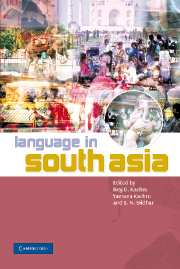Book contents
- Frontmatter
- Contents
- List of Figures
- List of Maps
- List of Tables
- Preface
- Acknowledgments
- List of Abbreviations
- Note on Transcription
- Introduction: languages, contexts, and constructs
- Part 1 Language history, families, and typology
- Part 2 Languages and their functions
- Part 3 Sanskrit and traditions of language study
- Part 4 Multilingualism, contact, and convergence
- 10 Contexts of multilingualism
- 11 Language contact and convergence in South Asia
- 12 Pidgins, Creoles, and Bazaar Hindi
- Part 5 Orality, literacy, and writing systems
- Part 6 Language conflicts
- Part 7 Language and modernization
- Part 8 Language and discourse
- Part 9 Language and identity
- Part 10 Languages in diaspora
- References
- Subject Index
- Language Index
- Author Index
12 - Pidgins, Creoles, and Bazaar Hindi
Published online by Cambridge University Press: 04 May 2010
- Frontmatter
- Contents
- List of Figures
- List of Maps
- List of Tables
- Preface
- Acknowledgments
- List of Abbreviations
- Note on Transcription
- Introduction: languages, contexts, and constructs
- Part 1 Language history, families, and typology
- Part 2 Languages and their functions
- Part 3 Sanskrit and traditions of language study
- Part 4 Multilingualism, contact, and convergence
- 10 Contexts of multilingualism
- 11 Language contact and convergence in South Asia
- 12 Pidgins, Creoles, and Bazaar Hindi
- Part 5 Orality, literacy, and writing systems
- Part 6 Language conflicts
- Part 7 Language and modernization
- Part 8 Language and discourse
- Part 9 Language and identity
- Part 10 Languages in diaspora
- References
- Subject Index
- Language Index
- Author Index
Summary
Introduction
This chapter focuses on one of the more exciting results of contact between groups speaking different languages: the birth of new languages to serve the need for intergroup communication. Typically, such languages draw most of their vocabulary from a single lexifier, but their grammar is a result of compromise among the speakers of the lexifier and substrate languages.
With its history as a cultural crossroads, South Asia has naturally provided the types of situations in which new languages might be expected to develop. Very few are reported, however, possibly because they actually do develop rarely, but also because they have traditionally been viewed as marginal phenomena – “bastardized” or “corrupt” versions of language, hence not worthy of study. The known new languages of South Asia, with the exception of Bazaar Hindi, are found around the fringes of the subcontinent and represent contacts with languages beyond the Indo-Aryan and Dravidian dominated heartland. A brief survey of the known new languages follows; later in this chapter, we will look at their linguistic characteristics.
Nagamese
The mountainous terrain of Nagaland (See Maps 12.1 and 12.2 on pp. 267, 268) has led, as in Papua New Guinea, to a large number of languages in a small area – a “choʈaasaa kintu bahubhaaʂii pradeʃ” (Kumar 1978: 1). Just as the people of Papua New Guinea embraced Tok Pisin, the Nagas have adopted Nagamese, an Assamese-lexified pidgin, as the chief lingua franca of their state, and it has become creolized as the mother tongue of the (non-Naga) Kachari community.
- Type
- Chapter
- Information
- Language in South Asia , pp. 253 - 268Publisher: Cambridge University PressPrint publication year: 2008
- 4
- Cited by

